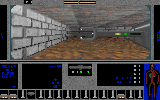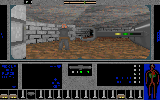| family and convert them for
use as animated characters in the game, or create new and exciting weapons.
The process of animating these characters is pretty involved and time-consuming,
but well worth the effort if you want your vision to be complete.
While animation, music, and sound files
go a long way towards making your game a unique and personalized experience,
not everybody wants to just run around and shoot stuff. So if you're interested
in creating something with a bit more depth than your average shooter,
you can import text strings to turn your virtual world into a mini adventure
game. You could create hostage situations, bank robberies or perhaps even
a nice Sunday school sermon that's interrupted by a group of leather-clad
bunnies spouting their radical propaganda.
While this feature opens up a lot of creative
ideas, there is a limit to the number of text files you can display in
a given game, but unless you're planning a first-person version of 'War
and Peace', this probably won't be a problem.
Pie in the Sky is also offering additional
libraries of ready-made wall textures, enemies, etc., but since the option
to modify the basic library of textures or design your own from scratch
is already built into the system, it's doubtful many users will need them.
Still, as customizable as the GCS is, there
are a few elements you won't be able to change. Unlike 'Doom' or 'Wolfenstein',
the game screen isn't resizable, and the status bar (where your health
and ammo stats appear) takes up a significant portion of the screen. These
things detract from the game, and they instantly label every game that's
created with this system. Also, the basic game engine doesn't include
the popular modem or network options that seems to be a near requirement
for any first-person shooter released today.
While there's little chance of seeing any
retail games created with the GCS, it'll probably inspire more than a few
ambitious gamers to release their creations online as share- ware or free
ware. It'll be interesting to see how far these would-be designers
can go with the tools GCS provides.
-Todd Vaughn |
Do-it
yourself
Gunplay
-
 Testing your
level for the first time is
Testing your
level for the first time is
pretty
exciting, especially when you've
filled
it full of bad guys. Say, didn't I
put a
guard around here somewhere?

Ahh, there
he is, just waiting to be
gunned
down. He looks so lonely, I
think
I'd better head back and make
him a
few friends. |
-
-
-
-
-
-
-
-
| HIGHS: A
simple interface, plenty of tools, and a library of objects to get
you started. |
81%
|
-
| LOWS: The
basic engine you're building on doesn't really stand a chance against the
current crop of 3D games. |
-
| BOTTOM LINE: A
reasonably priced construction kit that lets you show your
friends how games should be made. |
-
|
|




